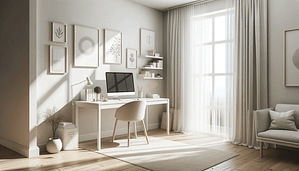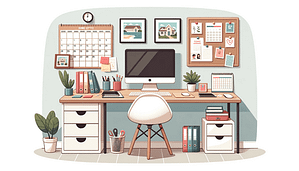Last Updated on 17 October 2023 by smallspacehub.com
Crafting the Perfect Minimalist Home Office

This page contains some Amazon affiliate links, meaning I get a commission if you decide to make a purchase through my links, at no cost to you.
When it comes to creating a minimalist small home office, it’s all about maximizing functionality while minimizing clutter. Think of it as crafting a space where every item has a purpose and every design choice enhances productivity. Here’s how you can achieve that:
1. Location 📍
Choosing the right spot in your home is the first step. Whether it’s a dedicated room, a cozy corner of your living room, or even a cleverly transformed closet, the location should resonate with your work style and blend seamlessly with your home’s design. And if you’re working with limited space, a fold-down desk is a game-changer, easily tucked away when your workday wraps up.
2. Furniture 🪑
The right furniture can make or break your workspace. Start with the essentials: a comfy office chair, a sturdy desk, and smart storage solutions. For those with smaller spaces, furniture that pulls double duty, like a desk with built-in storage or a bookshelf with an integrated workspace, can be lifesavers. And if you’re aiming to save even more space, consider options like foldable or wall-mounted desks.
3. Storage & Organization 🗂️
A clutter-free workspace is the heart of a minimalist office. Use a mix of containers, drawers, baskets, and bins to keep things neat. Wall-mounted shelves or bookcases offer extra storage without eating up floor space, and a streamlined filing system will keep your important documents at your fingertips.
4. Decor & Color Palette 🎨
While minimalist offices lean towards a neutral color palette, you can introduce warmth and texture with items like an area rug or the choice of wood for your furniture. Even subtle wall art can infuse personality into your workspace without overwhelming it.
5. Lighting 💡
Illumination is crucial. Apart from the main overhead lighting, task lighting focused on the desk area can reduce eye strain and improve concentration.
Minimalist Small Home Office Productivity Tools
Boosting productivity in a snug home office space is all about creating a vibe that champions focus, streamlines efficiency, and wraps you in comfort. Let’s dive into some strategies to craft that perfect workspace:
1. Light Up Your World 💡
The right illumination is a game-changer for productivity. There’s nothing like natural sunlight to uplift your mood. But, if the sun’s rays are playing hard to get, think about jazzing up your lighting fixtures. Have you heard of circadian lighting? Word has it that it can supercharge productivity by a whopping 20%!
2. Declutter Like a Pro 📦
Mess equals stress. Keep that workspace neat as a pin. Store those pens, papers, and post-its in drawers, cabinets, or stylish baskets. A tidy desk is the launchpad for your best ideas.
3. Claim Your Space 🚀
Set boundaries! Carving out a dedicated workspace is the secret sauce to balancing work and play. That corner? It’s for work and work alone. No blurring lines here.
4. Comfort is King 🪑
Comfort isn’t a luxury; it’s a necessity. Investing in ergonomic furniture is like giving yourself a productivity bonus. Check those desk and chair heights, and make sure your screen’s not playing hide and seek with your eyes.
5. Time’s on Your Side ⏰
Get friends with time management tools. Whether you’re a calendar junkie, a whiteboard wizard, or a daily planner devotee, lay out your tasks and dance to your own rhythm.
6. Personalize Your Nook 🖼️
Your workspace should scream “you”. Add those personal touches: a photo that sparks joy, artwork that inspires, or a plant that whispers “you got this.”
7. Hybrid is the New Black 💼
While remote work has its debates, the hybrid work model might just be the golden middle. It blends the comfort of home with the collaboration of an office.
What are some ways to stay motivated and focused while working from a minimalist small home office?
1. Dress the Part 👔
Here’s a fun thought: just because your new office buddy is a houseplant doesn’t mean you should ditch the office attire. Suiting up for work, even at home, sets the stage for a productive day. Studies suggest that casual dress can sometimes lead us astray, making us a tad too relax
2. Chart Your Course 🗓️
Ever heard the saying, “A goal without a plan is just a wish?” Well, it’s true. Organizing your day with clear goals, time blocks, and regular pit stops is like giving your productivity a GPS.
3. Master the Art of Focus 🎧
Distractions? We all have them. But reigning them in can turbocharge your work output. Whether it’s the allure of a buzzing phone or the siren call of the fridge, creating a distraction-free zone is key. And if the sound of silence isn’t your jam, a gentle playlist or a news recap might do the trick.
4. Stay in the Loop 💬
Remote work might have its perks, but it can sometimes feel like you’re on an island. Staying connected with your teammates can bridge that gap, keeping you motivated and in the know.
5. Recharge with Breaks ☀️
Who said breaks are for slackers? On the contrary, they’re productivity’s best friend. Take a breather, stretch those legs, and if you can, let the outdoors refresh your spirits. Try the Pomodoro method, it works for me!
The Pomodoro Technique
The Pomodoro Technique is a time management method developed by Francesco Cirillo in the late 1980s. The approach is named after the Italian word for “tomato” because Cirillo initially used a tomato-shaped kitchen timer to track his work intervals. The fundamental principle of the Pomodoro Technique is to break work into short, focused intervals, traditionally 25 minutes in length, followed by a short break of 5 minutes. These intervals are known as “pomodoros.”
The process is straightforward:
- Choose a task you want to work on.
- Set a timer for 25 minutes and work on the task until the timer rings.
- Take a 5-minute break.
- Repeat the cycle. After completing four pomodoros, take a longer break, typically 15-30 minutes.
This method is designed to improve efficiency, maintain high levels of focus, and reduce the fatigue associated with prolonged work sessions. The regular breaks ensure that the brain gets the rest it needs to maintain optimal performance. Moreover, the act of starting a timer creates a commitment to focus solely on the task at hand, discouraging multitasking and distractions.
By compartmentalizing work into these structured blocks, individuals often find that they can accomplish more in less time and with less mental exhaustion. Over time, users of the Pomodoro Technique may also develop a better understanding of how long tasks take, aiding in more effective planning and time management.
To wrap it all up, the secret recipe for a high-octane home office? A space that champions focus, efficiency, and oodles of comfort.


